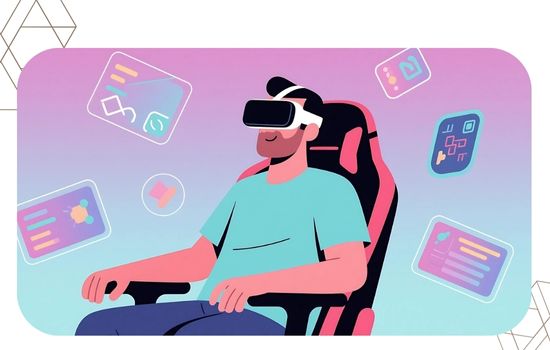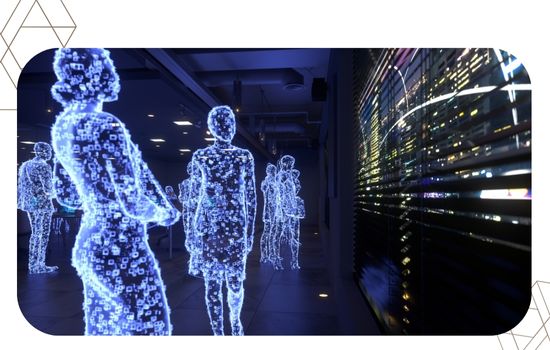Advertisements
In a world where the digital and the physical converge, the phrase The Metaverse: What It Is and How It Could Transform Everyday Life becomes more than just a headline:

It's an invitation to explore how our routines, relationships, work, and recreation could radically change.
Below, you'll find a summary of what it's all about, three key areas of development, and some conclusions to help you understand and prepare for this evolution.
Summary
- Definition and current state of the metaverse
- Areas of transformation: work and education, consumption and economy, social life and entertainment
- Opportunities and risks that should be addressed
- Conclusion and FAQs
Definition and current state of the metaverse
When it is said The Metaverse: What It Is and How It Could Transform Everyday Life, is referring to a persistent, interoperable digital environment.
Advertisements
Where you interact through avatars or virtual representations, seamlessly connecting physical and virtual experiences.
This concept is largely based on technologies such as virtual reality (VR), augmented reality (AR), artificial intelligence, blockchain, and high-speed networks.
For example, according to a 2022 Pew Research Center study.
54% of the surveyed experts believe that by 2040 the metaverse “will be a much more refined and truly immersive part of daily life” for hundreds of millions of people.
Additionally, an Accenture report estimated that the commercial opportunities of the metaverse could reach US$ 1 billion (1 trillion dollars) by the end of 2025.
To illustrate this with an analogy: imagine the transition from the internet in the 1990s to mobile was like going from TV to smartphone.
What we're now envisioning with the metaverse is similar to moving from a smartphone to a "connected environment" where you no longer look at a screen, but instead "experience" immersed interactions.
Areas of transformation in everyday life
Work and education
The exploration of The Metaverse: What It Is and How It Could Transform Everyday Life includes thinking about how your way of working or learning will change.
Instead of physical conference rooms or traditional video calling platforms, you might find yourself with three-dimensional virtual offices.
Immersive classrooms where you can view 3D objects or simulate real-life scenarios, and collaborative tools that expand the boundaries of physical location.
For example, a company can create a virtual replica of its plant for risk-free staff training.
Or a university can offer a completely virtual lab where students manipulate 3D models as part of their learning.
This opens up possibilities for efficiency, cost reduction and access flexibility.
Consumption, economy and trade
The economic aspect of The Metaverse: What It Is and How It Could Transform Everyday Life is equally significant.
Brands are no longer just selling physical products: they are offering experiences, digital assets (such as avatars or skins), and virtual stores that emulate or surpass the real-world experience.
Here's a relevant fact: Accenture's study indicated that 55% of consumers surveyed see the metaverse as an opportunity for content creation and monetization.
An original example: Imagine you buy a unique piece of digital art for your “virtual home” in the metaverse, and then that asset can increase in value when it is marketed.
Another: A neighborhood coffee shop opens a virtual branch where customers “visit” with their avatar, choose a specialty coffee, and chat with each other in an immersive environment.
Reducing the need for physical structure.
Social life and entertainment
Finally, when addressing The Metaverse: What It Is and How It Could Transform Everyday Life, it is worth thinking about the way we relate, entertain, connect.
Concerts, cultural events, virtual trips, and get-togethers with friends can take on a more immersive twist.
You'll no longer just see a screen: you'll enter a shared virtual space, interacting with others in three dimensions.
A second example: a group of friends living in different cities “meet” on a virtual beach at sunset, chat, play, and watch the digital sunset together.
Or, a musician offers a recital in a virtual stadium that scales to thousands of attendees regardless of geographic location.
Opportunities and risks that should be addressed
Opportunities
- Innovation in business models: creation of digital assets, new virtual economies, subscription services, and personalized experiences.
- Geographic inclusion: People in remote areas can access quality environments that previously required physical presence.
- More interactive and effective education and training, with simulations that replace less dynamic theoretical classes.
- New forms of socialization that can break down physical barriers and facilitate global connections.
Risks and challenges
- Data privacy and security: The virtual environment will generate enormous volumes of personal and behavioral information.
- Technological inequality: If access to devices, networks, and education is not balanced, some people will be excluded.
- Mental health and well-being: The lines between physical and virtual life may blur, raising questions about addiction, displacement from real-life relationships, or eye/motor health.
- Regulation and ownership: The system is still unregulated in many countries, and the virtual economy poses legal challenges (e.g., copyright, jurisdiction).
- Hype vs. actual adoption: Although the technology is progressing, there is still no metaverse widely adopted by the general public. According to Pew experts, only 54% of % expect significant adoption by 2040.

Read more: History of the first video games
How to prepare for this transformation?
- Get informed and experiment: It's not enough to hear about "the metaverse"; it's worth trying out VR/AR environments and understanding their possibilities and limitations.
- Evaluate personal or professional useIf you're a professional, consider how your field can transition to immersive environments (e.g., marketing, training, healthcare). If you're a user, explore experiences that can bring you real value.
- Prioritize infrastructure: good connection, compatible devices, basic knowledge of virtual interaction.
- Maintaining balance between the physical and the virtualDigital life can complement, but not replace, the human experience; the key lies in healthy integration.
- Observe ethics and regulationsBy following discussions about privacy, digital ownership, and governance, you'll be in a stronger position to act responsibly.
Conclusion
In summary, The Metaverse: What It Is and How It Could Transform Everyday Life It ceases to be a futuristic concept and becomes a platform of possibilities.
It's not just about "putting on virtual reality headsets" or living in a perpetual video game; we're talking about an ecosystem where the digital and physical interact in unprecedented ways.
This new environment could redefine the way you work, learn, shop, interact, and entertain.
Just as the internet changed everything decades ago, the metaverse offers another layer of change, but not without challenges.
You need to be ready to adapt, question, experiment, and actively decide how you want to participate.
Isn't it intriguing to imagine that your next coffee, meeting, or concert could take place in a virtual space that you inhabit as an avatar, from your city, your country, your couch?
Well, that's the door this universe opens. The question is: are you ready to enter?
Read more: Augmented and virtual reality: the future of entertainment
Frequently Asked Questions
- Does the metaverse mean that “real” life will disappear?
No. The goal is not to replace physical life, but to complement it. Technology will be an additional means, not a substitute for human life. - When will it be available to everyone?
There's no exact date. According to experts, it could be widely adopted by 2040-2050. Some components are already in use, but the "full metaverse" is still being built. - Do I need a virtual reality headset to participate?
Not necessarily. While many immersive environments use headsets or visors, others can be operated via computers, tablets, or smartphones. Over time, these devices will become more accessible. - What are the costs?
They vary. Initial costs can be high (VR headsets, good connections), but as the technology matures and scales, costs are expected to decrease. - Is it safe to participate?
Security is one of the challenges. It's recommended to adopt responsible practices: educate yourself about privacy, manage your personal data, and alternate between virtual and physical environments.